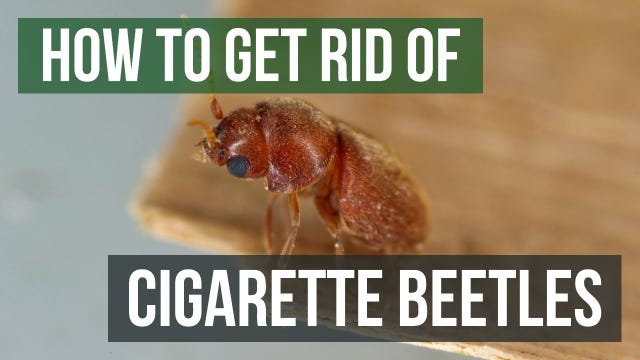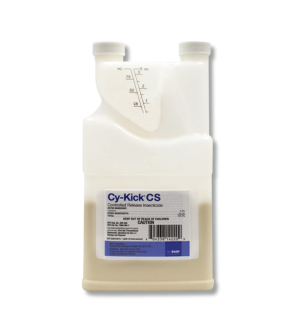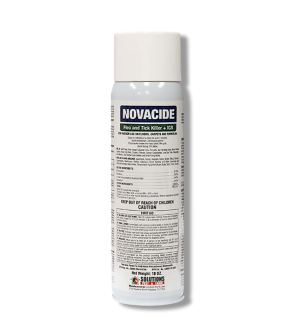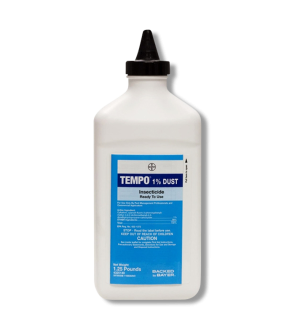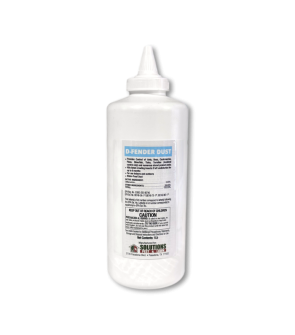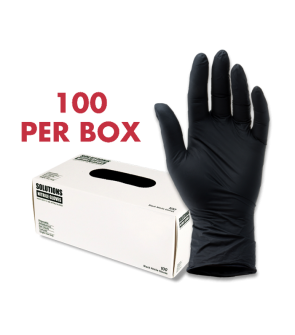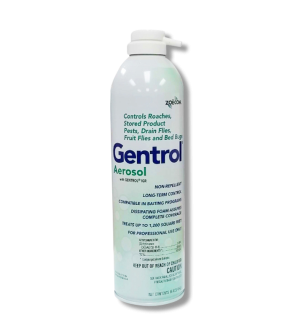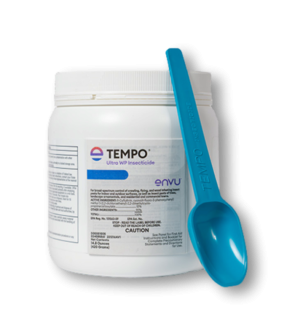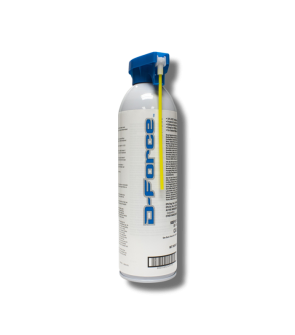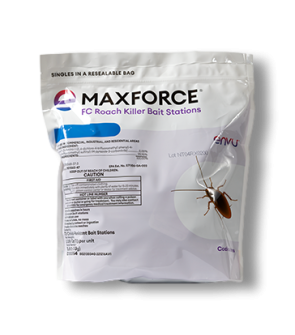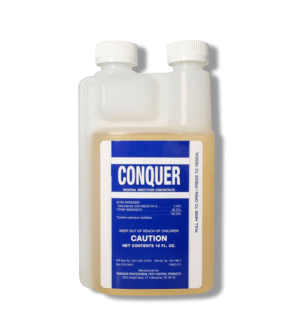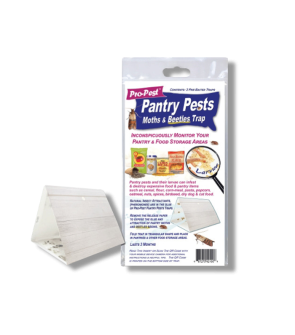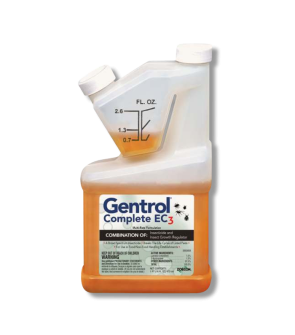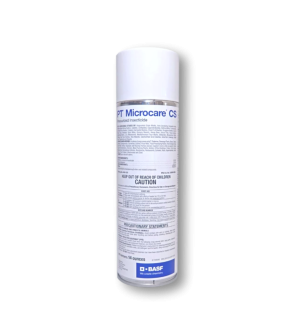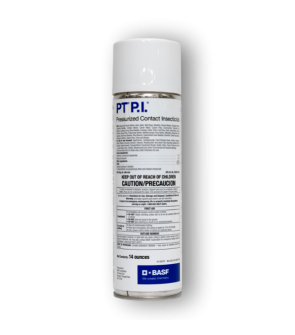Gain access to personalized product screening, the best pricing, rewards, and more!
Most Effective Products
Cigarette Beetle Control: How To Get Rid of Cigarette Beetles
This page is a general cigarette beetle control guide. Using the products and methods suggested, you will get control of cigarette beetles. Follow this guide and use the recommended products, and we guarantee 100% control over cigarette beetles.
Dried stored foods are commonly at risk of being invaded by pantry pests. The same is the case for tobacco, which has a bug that specifically targets dried tobacco leaves, cigars, cigarettes, or chewing tobacco. That bug is the cigarette beetle, which has invaded human dwellings and food storage areas for a long time.
Oval-shaped, brown in color, and reaching up to 1/8th of an inch long, cigarette beetles closely resemble drugstore beetles. Despite their name, cigarette beetles are not limited to tobacco products; they will invade packaged foods and grains as well. Cigarette beetles feed constantly, eating seeds, seasonings like pepper and paprika, and dried flower arrangements.
Cigarette beetles commit most of their damage while in their larvae stage. The female cigarette beetle can lay up to 100 eggs on the food sources where they gather, and when hatched, the larvae become hungry, insatiable destroyers. Adult cigarette beetles are skilled flyers who can enter the house and create havoc in pantries.
Cigarette beetles can be tough to control with insecticides because they are also known to eat pyrethrum, the main active ingredient found in a variety of pesticides. If you’re concerned about an invasion of cigarettes, our DIY treatment guide below can help with recommendations of professional-grade products and helpful how-to advice to rid these pests once and for all.
Identification
Before you can proceed with a treatment program, you will need to be sure you have cigarette beetle infestations. Misidentification can lead you to use the wrong treatment products and waste time and money. Below are some characteristics of cigarette beetles to aid in identification:
- Cigarette beetles are a common pantry pest that is less than 1/8 of an inch in length and is reddish-brown. Adult cigarette beetles can fly and are drawn to areas with light.
- Cigarette beetles are often mistaken for drugstore beetles due to their oval shape. If you were to observe the two closely, you would see some obvious traits that can be used to help differentiate between the two beetle species. The first is that the cigarette beetle has more of a humpback shape than the drugstore beetle. Secondly, when examining the wings of the drugstore beetle, one would notice deep grooves or pits, while the cigarette beetle's wings appear smooth. Cigarette beetles also have more hairs on their bodies than the drugstore beetle, which gives them a more fuzzy-looking appearance.
Use the image and description above to help you properly identify the cigarette beetle. If you are unsure, contact us, and we will help you identify the problem.
Inspection
After properly identifying the cigarette beetle, an inspection is necessary to determine where cigarette beetles are infesting. During the inspection, you will focus on finding this problem: "hotspots" where cigarette beetles are commonly found.

Where To Inspect
Begin by looking at areas where food goods are stored. Check the cabinets, shelves, and pantries. Check kitchens and garages. Inspect every package of grains, cereals, starches, flour, spices, herbs, pasta, and pet food packaging.
What To Look For
You're looking for contaminated food products. Inspect all the places mentioned above. The contaminated packages will have larvae and adult cigarette beetles crawling inside the grain, cereal, or food product. Once you have found a contaminated food product, you will apply the treatment.
Treatment
Once you have confirmed cigarette beetle activity, it is time to begin treatment. Remember to read all product labels, follow the application instructions on these labels, and stay safe by wearing personal protective equipment (PPE).
The best way to control cigarette beetle infestations in your pantry is to discard all your stored dried food products, perform a deep cleaning, and then apply Pyrid Aerosol and Flex 10-10 Insecticide to kill adult cigarette beetles that survive cleanup. Finally, placing Pro-Pest Pantry Moth and Beetle Traps would be best to capture any straggler cigarette beetles.
Step 1: Preliminary Cleanup and Vacuuming
Start by removing all the food goods in the areas where the infestation occurred. Investigate your food items to locate the main food item or items they are found in and are eating. Most cigarette beetle adults will emerge from cocoons near where larvae have eaten. If you have discovered adult cigarette beetles in the pantry, you most likely have some cereal, spice, flour, cookie, grain, bean, or some other item you are actively eating.
We recommend that you clear out everything you have stored in your cabinets and toss them out so you leave nothing to chance. This is also a time-saving measure; otherwise, you would have to go through every single item to check if they have been infested, which can be quite time-consuming. Inspect boxes and containers carefully for white worm-like larvae, adults, and empty cocoons (empty cocoons are evidence that adults have hatched).
Once everything has been tossed, vacuum your pantry shelves. Focus on crevices and corners to ensure that active larvae and eggs are removed. Then, take soapy, warm water, dunk a rag, and wipe the shelves, cupboards, and surfaces.
Step 2: Treat Cracks and Crevices with Pyrid Aerosol
Pyrid Aerosol is a synthetic pyrethroid insecticide used as a flushing agent and effective as a crack and crevice treatment inside pantries. Cigarette beetles tend to hide in small crevices and lay eggs, so Pyrid will help flush them out and kill them with contact.
Pyrid comes with a convenient crack-and-crevice applicator tip that helps to spray the product more accurately into cracks and crevices. Remove the white applicator from the top of the can and replace it with the red straw-tip applicator.
Shake well, and then spray the Pyrid along the length of the cracks and crevices of your pantry shelving in quick bursts, usually at about 1 second of spray per foot. Pyrid will flush pests out of these areas. Pyrid Aerosol doesn't leave behind a residual but will knock down Cigar beetles quickly.
Step 3: Apply Flex 10-10
After applying Pyrid to your cracks and crevices, follow up with an application of Flex 10-10 Insecticide. Flex 10-10 is a pyrethroid insecticide with a residual effect of up to 30 days and will continue to kill cigarette beetles long after you have applied it.
Use Flex 10-10 as a general surface spray to spot-treat the pantry shelves. Start by diluting the appropriate Flex 10-10 amount into a pump sprayer.
Calculate the square footage of your pantry. Find the square footage by measuring the treatment areas' length and width in feet, then multiplying them together (length X width = square footage).
Based on your calculations, mix the Flex 10-10 at a rate of 3.2 fl. oz. per gallon of water to treat 750 sq. ft. of surface area. Use 6.4 fl. oz. of product per gallon of water for heavy infestations.
Fill the sprayer with a half-gallon of water, add the appropriate amount of Flex 10-10, then fill the rest with water and shake the sprayer.
Apply the Flex 10-10 as a low-pressure fan spray along the back and side edges of the pantry shelving where the shelf meets the wall.
Keep people and pets away from the treated area until dry. Once the Flex 10-10 is dry, your pantry can be restocked.
Step 3: Pro-Pest Pantry Moth and Beetle Traps
Pro-Pest Pantry Moth and Beetle Traps are glue traps infused with pantry pest pheromones that lure unsuspecting cigarette beetles to the trap. They can be set on shelves or hung to capture many crawling or flying insects.
Pro-Pest Traps will stay effective for at least three months and cover 300 sq. ft. of area.
To use them, peel off the wax paper, fold them into a tent, or leave them flat and place them in the areas where the infestation took place.
Place the trap on the pantry shelving where it won’t get smashed and will be left generally undisturbed. These traps can also be hung in pantries away from food for added convenience.
Prevention
Once you have controlled the cigarette beetle infestation, you will need to take preventative measures to ensure they don't return to your pantry.
- Start by regularly checking food packages before you buy them. Inspect the packages for possible tears, holes, or punctures. Many times, an infestation is already inside.
- Also, get in the habit of taking out the food products from their original packaging and putting them into tight-fitting plastic containers.
- Take action to prevent excess clutter in your pantries. If you buy just enough food for a week, you won't have tons of products sitting for months without being used, which will prevent the possibility of creating an infestation.
- Remember to put every food product into plastic containers. This will prevent cigarette beetles from infesting your food and might also isolate a current infestation so that it does not affect other food products.
- Finally, you can use Pro-Pest traps throughout the year to monitor and control infestations before they happen.
Key Takeaways
What Are Cigarette Beetles?
- Cigarette beetles are a pantry invading insect known for infesting tobacco materials but can also infest non-tobacco products.
How to Get Rid of Cigarette Beetles
- To control cigarette beetles, you will need to clean up your pantry and thoroughly discard infested items. Once that is done, follow up with an application of Novacide Aerosol and Pro-Pest Pantry Moth and Beetle Traps.
Prevent Cigarette Beetle Reinfestations
- Remember that without enacting preventative measures, you might suffer from another infestation. Get in the habit of putting all food products in plastic containers and inspecting packaging before buying.






